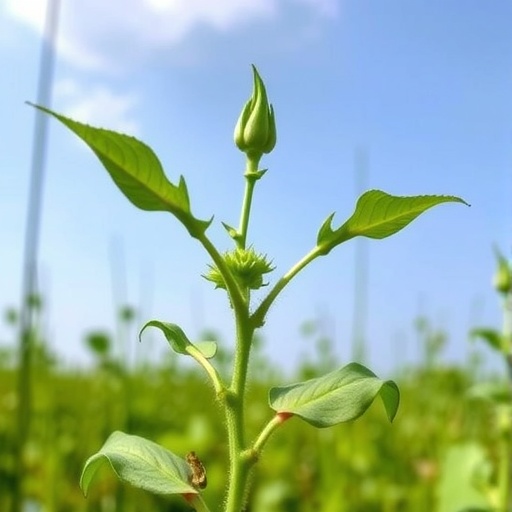UNDER EMBARGO UNTIL 19:00 BST / 14:00 ET THURSDAY 17 APRIL 2025
Sugar-like Molecule Reveals New Insights into the Mechanisms of Plant Disease Virulence
In a groundbreaking study led by researchers at the University of Oxford, the unusual sugar-mimicking molecule known as glycosyrin has garnered attention for its pivotal role in the virulence of a significant bacterial pathogen affecting tomato crops, specifically the strain of Pseudomonas syringae. This microorganism adeptly exploits the weaknesses of plant immune responses, contributing to extensive agricultural losses globally. The research illustrates how glycosyrin, by masquerading as galactose, effectively subverts plant defenses and challenges traditional understandings of plant-pathogen interactions.
The findings reveal that the pathogen generates glycosyrin to inhibit immune responses within the critical intercellular spaces of plant tissue. This subterfuge enables the bacteria to persist undetected, thereby threatening the integrity of important food sources. Glycosyrin’s structural similarity to galactose, a naturally occurring sugar involved in various biological processes, is integral to its function as a stealthy invader. Such mimicry exemplifies a sophisticated adaptive strategy, allowing the pathogen to bypass plant recognition mechanisms and thrive within host tissues.
Professor Renier van der Hoorn, the lead investigator from the University of Oxford’s Department of Biology, emphasized the significance of this discovery. The research team’s elucidation of glycosyrin’s structure and its biochemical pathways marks a substantial advancement in our understanding of bacterial virulence factors. By clarifying how glycosyrin manipulates the glycobiology of plants, the study opens potential avenues for developing innovative agricultural treatments aimed at enhancing crop resilience against pathogenic threats.
In addition to its roles in plant pathology, glycosyrin has been observed to possess properties akin to ‘iminosugars’, a class of compounds that hold therapeutic promise for metabolic disorders in humans, such as type-II diabetes. The unique molecular architecture of glycosyrin sets it apart from other iminosugars, leading researchers to speculate about its potential medicinal applications. This duality of function – both as a pathogen virulence factor in plants and a candidate for therapeutic use in humans – is particularly intriguing and warrants further investigation.
The study also uncovered that the mechanism by which glycosyrin operates is complex, often contingent upon the regulation of specific genes associated with the bacterium’s virulence. While some P. syringae strains have adapted alternative tactics to conceal gene products, they nonetheless produce glycosyrin, suggesting multifaceted roles for this molecule beyond immune evasion. Furthermore, it is posited that glycosyrin could modify cell wall characteristics and affect the broader context of cellular communication, leading to a more intricate interplay between pathogens and their plant hosts.
The interdisciplinary nature of this research project, which encompasses structural biology, synthetic chemistry, and bacterial genetics, underscores the diverse methodologies required to unravel the complexities of pathogen interactions with host organisms. Collaborators within the research team included experts from various fields, facilitating a comprehensive exploration of glycosyrin’s biosynthesis and functional implications.
Utilizing familiar laboratory techniques, including the renowned LacZ gene assay typically employed by first-year biology students, the researchers capitalized on the glycosyrin-induced inhibition of the LacZ product to identify and isolate the associated biosynthesis genes. This methodological choice not only showcased the enduring relevance of foundational scientific techniques but also highlighted the creative experimentation enabling novel discoveries in the field of plant-pathogen interactions.
The research’s implications span beyond tomatoes, as Pseudomonas syringae is known to infect a wide array of host plants, including economically important species such as almond, olive, leek, and bean. The conservation of iminosugar biosynthesis genes across different bacterial strains suggests that glycosyrin may represent a common strategy among various plant pathogens, enhancing our understanding of agricultural vulnerabilities and informing strategies for crop protection.
The publication of these findings in the esteemed journal Science heralds a pivotal moment in plant biology, signaling a potential paradigm shift in strategies for managing crop diseases. As agricultural stakeholders grapple with the increasing impact of microbial diseases on food security, the insights gleaned from this study may inform more effective disease management practices and foster the development of robust, disease-resistant crop varieties.
In conclusion, the revelations surrounding glycosyrin’s role as a pathogen’s secret weapon foreground the intricate relationship between plants and the microorganisms that threaten their survival. As research delves deeper into the molecular underpinnings of such interactions, it becomes evident that understanding these complexities is essential for developing innovative solutions to safeguard food systems against emerging threats.
The research team’s ongoing exploration into glycosyrin and its myriad implications serves not only as a testament to human ingenuity in scientific discovery but also as a clarion call for continued investment in agricultural research. As the field evolves, it promises to unveil further insights that could significantly influence the future of sustainable agriculture and food security in a changing world.
Subject of Research: The role of glycosyrin in the virulence of Pseudomonas syringae in plants.
Article Title: Bacterial pathogen deploys the iminosugar glycosyrin to manipulate plant glycobiology.
News Publication Date: 18-Apr-2025.
Web References: http://dx.doi.org/10.1126/science.adp2433.
References: Not specified.
Image Credits: Not specified.
Keywords
Plant pathology, *Pseudomonas syringae*, glycosyrin, iminosugars, crop disease, plant immunity, agricultural research, microbial virulence, food security.




